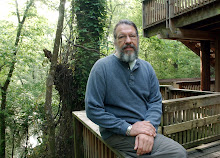Nutmeg Hickory Leaf (Carya myristiciformes)
26 Nov 2010, Lafayette Parish
“But ask the beasts, and they will teach you;
the birds of the air, and they will tell you;
or the plants of the earth, and they will teach you...”
Job 12:7
Down here on the Gulf Rim – at the continental border of temperate and tropical air masses – the seasons of the year tend to run into one another, making it difficult to know where one ends and another begins. Throw in a lil' global-warming and the edges grow even murkier. The real kicker, though, is that through it all, humans are getting ecologically-dumber by the minute. The divorce between human civilization and the natural world is all but complete. Perhaps I exaggerate . . . but papers have been filed, for sure . . .
Anyway, for those who do happen to pay attention to the natural world – and let's be succinct and call that world what it truly is: “Reality-with-a-capital-R” – it's cool to have the birds of the air and the plants of the earth around to remind us of what season it is.
White-throated Sparrow, photo by Russ Norwood
Down at this latitude (about 50 miles north of the Gulf Coast), for example, we should not say that winter is here until the White-throated Sparrow has arrived and settled in. Each winter, White-throated Sparrows occupy just about any shrubby forest edge down here, including properly-arrayed urban and suburban backyards. Really, you don't even have to see them. Like so many other winter birds down here, they are very vocal, uttering their loud, musical, “tEA!” (or “dEE!” or “chEE!” or “pwEE!” depending on your ear...) orientation calls each dawn and dusk; and occasionally breaking out into their mournful “old-Sam-Pea-body” territorial breeding song.
Eastern Towhee, photo by J. Spohrer
Ditto for other local winter-resident birds, including the Eastern Towhee, that big, handsome “sparrow of the briars.” Generally, towhees prefer wilder settings, so their penetrating, “jREE!” dawn/dusk orientation call is heard only occasionally in urban/suburban forests.
Yellow-rumped Warbler, photo by Russ Norwood
Birds that breed in North America and overwinter in the Central/South American tropics are known as Neotropical migrants; as opposed to birds that breed to our north and overwinter down here along the Gulf Coast, which are referred to as Nearctic migrants. The most common of the nearctics around these parts include species like Yellow-bellied Sapsucker, American Robin, Cedar Waxwing, Yellow-rumped Warbler, and Ruby-crowned Kinglet.
Eastern Phoebe, photo by Russ Norwood
Another fairly common local overwinterer is the Eastern Phoebe, a graceful, mockingbird-sized flycatcher. Its drabish colors and relatively sedentary feeding habit often renders it invisible to non-birders; but its loud, reedy, “fee-BEE, fee-BEE” call echos through the woodland habitats (woodlands around water are its absolute favorite) that it frequents.
Nutmeg Hickory (Carya myristiciformes)
26 Nov 2010, Lafayette Parish
If bird-detection proves too much work, then the local trees fairly shout out in-your-face-style that fall is gone and winter's here. That's right, we do not have much of a fall foliage color show down here. What we do have is a winter fall foliage color show!
American Hornbeam Foliage (Carpinus caroliniana)
26 Nov 2010, Lafayette Parish
It is said that end-of-season foliage color is a product of that tree's metabolic wastes, sequestered in its leaves and visible only after chlorophyll production ceases. As green chlorophyll cells peter out, the oranges, yellows, and reds of these wastes are made manifest.
Sassafras (Sassafras albidum)
07 Oct 2004, probably in n. Illinois
So the situation down here is that in October and the first half of November, our trees are still working – still making and storing food – while trees of the northeastern U.S. and upper-Midwest have thrown in the towel for the year and given up their chlorophyll. The time to start looking around here for foliage color is right around Thanksgiving, at the onset of winter.
Swamp Red Maple (Acer drummondii)
19 Dec 2005, Lafayette Parish
Even if you don't have room for any more trees at your place, take a post-Thanksgiving drive to your local woods in late November. You'll see winter color, baby. While you're driving, you may as well continue north to the Interstate-20 corridor, where you'll find Louisiana's finest winter color show. The most easily accessible winter foliage color destination around Shreveport is the Walter B. Jacobs Memorial Nature Park (http://www.caddoparks.com/memorial.cfm). In northeastern Louisiana, my personal all-time state favorite for winter foliage color is the Sicily Island Hills Wildlife Management Area (http://sicilyislandhills.com/).











Great piece, as always, Bill. Thanks for hipping us to the two areas in North La.
ReplyDelete